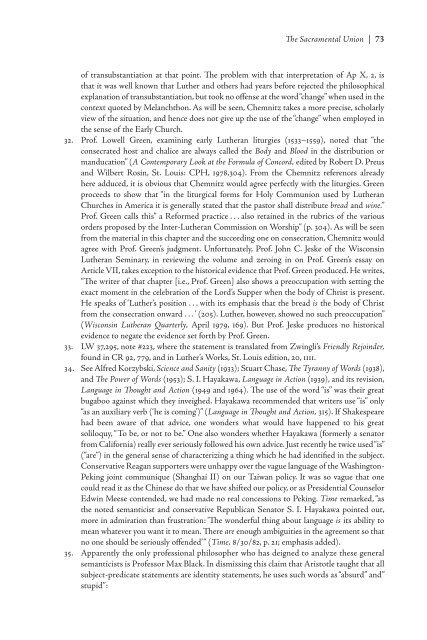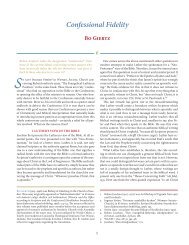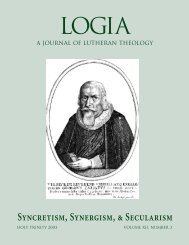The Lord's Supper in the Theology of Martin Chemnitz Bjarne - Logia
The Lord's Supper in the Theology of Martin Chemnitz Bjarne - Logia
The Lord's Supper in the Theology of Martin Chemnitz Bjarne - Logia
Create successful ePaper yourself
Turn your PDF publications into a flip-book with our unique Google optimized e-Paper software.
<strong>The</strong> Sacramental Union |<br />
<strong>of</strong> transubstantiation at that po<strong>in</strong>t. <strong>The</strong> problem with that <strong>in</strong>terpretation <strong>of</strong> Ap X, 2, is<br />
that it was well known that Lu<strong>the</strong>r and o<strong>the</strong>rs had years before rejected <strong>the</strong> philosophical<br />
explanation <strong>of</strong> transubstantiation, but took no <strong>of</strong>fense at <strong>the</strong> word“change” when used <strong>in</strong> <strong>the</strong><br />
context quoted by Melanchthon. As will be seen, <strong>Chemnitz</strong> takes a more precise, scholarly<br />
view <strong>of</strong> <strong>the</strong> situation, and hence does not give up <strong>the</strong> use <strong>of</strong> <strong>the</strong> “change” when employed <strong>in</strong><br />
<strong>the</strong> sense <strong>of</strong> <strong>the</strong> Early Church.<br />
32. Pr<strong>of</strong>. Lowell Green, exam<strong>in</strong><strong>in</strong>g early Lu<strong>the</strong>ran liturgies (1533–1559), noted that “<strong>the</strong><br />
consecrated host and chalice are always called <strong>the</strong> Body and Blood <strong>in</strong> <strong>the</strong> distribution or<br />
manducation” (A Contemporary Look at <strong>the</strong> Formula <strong>of</strong> Concord, edited by Robert D. Preus<br />
and Wilbert Ros<strong>in</strong>, St. Louis: CPH, 1978,304). From <strong>the</strong> <strong>Chemnitz</strong> references already<br />
here adduced, it is obvious that <strong>Chemnitz</strong> would agree perfectly with <strong>the</strong> liturgies. Green<br />
proceeds to show that “<strong>in</strong> <strong>the</strong> liturgical forms for Holy Communion used by Lu<strong>the</strong>ran<br />
Churches <strong>in</strong> America it is generally stated that <strong>the</strong> pastor shall distribute bread and w<strong>in</strong>e.”<br />
Pr<strong>of</strong>. Green calls this” a Reformed practice . . . also reta<strong>in</strong>ed <strong>in</strong> <strong>the</strong> rubrics <strong>of</strong> <strong>the</strong> various<br />
orders proposed by <strong>the</strong> Inter-Lu<strong>the</strong>ran Commission on Worship” (p. 304). As will be seen<br />
from <strong>the</strong> material <strong>in</strong> this chapter and <strong>the</strong> succeed<strong>in</strong>g one on consecration, <strong>Chemnitz</strong> would<br />
agree with Pr<strong>of</strong>. Green’s judgment. Unfortunately, Pr<strong>of</strong>. John C. Jeske <strong>of</strong> <strong>the</strong> Wiscons<strong>in</strong><br />
Lu<strong>the</strong>ran Sem<strong>in</strong>ary, <strong>in</strong> review<strong>in</strong>g <strong>the</strong> volume and zero<strong>in</strong>g <strong>in</strong> on Pr<strong>of</strong>. Green’s essay on<br />
Article VII, takes exception to <strong>the</strong> historical evidence that Pr<strong>of</strong>. Green produced. He writes,<br />
“<strong>The</strong> writer <strong>of</strong> that chapter [i.e., Pr<strong>of</strong>. Green] also shows a preoccupation with sett<strong>in</strong>g <strong>the</strong><br />
exact moment <strong>in</strong> <strong>the</strong> celebration <strong>of</strong> <strong>the</strong> Lord’s <strong>Supper</strong> when <strong>the</strong> body <strong>of</strong> Christ is present.<br />
He speaks <strong>of</strong> ‘Lu<strong>the</strong>r’s position . . . with its emphasis that <strong>the</strong> bread is <strong>the</strong> body <strong>of</strong> Christ<br />
from <strong>the</strong> consecration onward . . . ’ (205). Lu<strong>the</strong>r, however, showed no such preoccupation”<br />
(Wiscons<strong>in</strong> Lu<strong>the</strong>ran Quarterly, April 1979, 169). But Pr<strong>of</strong>. Jeske produces no historical<br />
evidence to negate <strong>the</strong> evidence set forth by Pr<strong>of</strong>. Green.<br />
33. LW 37,295, note #223, where <strong>the</strong> statement is translated from Zw<strong>in</strong>gli’s Friendly Rejo<strong>in</strong>der,<br />
found <strong>in</strong> CR 92, 779, and <strong>in</strong> Lu<strong>the</strong>r’s Works, St. Louis edition, 20, 1111.<br />
34. See Alfred Korzybski, Science and Sanity (1933); Stuart Chase, <strong>The</strong> Tyranny <strong>of</strong> Words (1938),<br />
and <strong>The</strong> Power <strong>of</strong> Words (1953); S. I. Hayakawa, Language <strong>in</strong> Action (1939), and its revision,<br />
Language <strong>in</strong> Thought and Action (1949 and 1964). <strong>The</strong> use <strong>of</strong> <strong>the</strong> word “is” was <strong>the</strong>ir great<br />
bugaboo aga<strong>in</strong>st which <strong>the</strong>y <strong>in</strong>veighed. Hayakawa recommended that writers use “is” only<br />
“as an auxiliary verb (‘he is com<strong>in</strong>g’)” (Language <strong>in</strong> Thought and Action, 315). If Shakespeare<br />
had been aware <strong>of</strong> that advice, one wonders what would have happened to his great<br />
soliloquy, “To be, or not to be.” One also wonders whe<strong>the</strong>r Hayakawa (formerly a senator<br />
from California) really ever seriously followed his own advice. Just recently he twice used“is”<br />
(“are”) <strong>in</strong> <strong>the</strong> general sense <strong>of</strong> characteriz<strong>in</strong>g a th<strong>in</strong>g which he had identified <strong>in</strong> <strong>the</strong> subject.<br />
Conservative Reagan supporters were unhappy over <strong>the</strong> vague language <strong>of</strong> <strong>the</strong> Wash<strong>in</strong>gton-<br />
Pek<strong>in</strong>g jo<strong>in</strong>t communique (Shanghai II) on our Taiwan policy. It was so vague that one<br />
could read it as <strong>the</strong> Ch<strong>in</strong>ese do that we have shifted our policy, or as Presidential Counselor<br />
Edw<strong>in</strong> Meese contended, we had made no real concessions to Pek<strong>in</strong>g. Time remarked, “as<br />
<strong>the</strong> noted semanticist and conservative Republican Senator S. I. Hayakawa po<strong>in</strong>ted out,<br />
more <strong>in</strong> admiration than frustration: ‘<strong>The</strong> wonderful th<strong>in</strong>g about language is its ability to<br />
mean whatever you want it to mean. <strong>The</strong>re are enough ambiguities <strong>in</strong> <strong>the</strong> agreement so that<br />
no one should be seriously <strong>of</strong>fended’“ (Time, 8/30/82, p. 21; emphasis added).<br />
35. Apparently <strong>the</strong> only pr<strong>of</strong>essional philosopher who has deigned to analyze <strong>the</strong>se general<br />
semanticists is Pr<strong>of</strong>essor Max Black. In dismiss<strong>in</strong>g this claim that Aristotle taught that all<br />
subject-predicate statements are identity statements, he uses such words as “absurd” and”<br />
stupid”:




